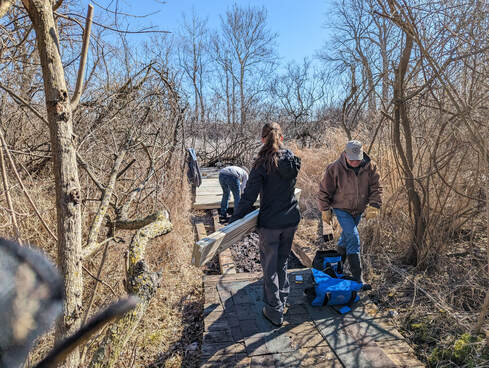Enjoying our blogs?Your support helps BSBO continue to develop and deliver educational content throughout the year.
|
 Cold and wet, but still smiling! Cold and wet, but still smiling! Although it may be hard to believe when looking at the weather right now…spring has sprung! We’ve been out in the marsh for a few weeks now, since the very beginning of April, and there’s been a fair amount going on already. We started off by doing some necessary maintenance, and we were very lucky to have some employees of the Toledo Museum of Art come out to help us for a day. They were real troopers and worked through a bit of rain before heading to the BSBO office to help organize some things for Biggest Week. It was very generous of them to donate their time to us, and they really proved that many hands make light work! Our other big, pre-season chore was everybody’s favorite job: boardwalk repair. Luckily, we didn’t replace nearly as many boardwalks as we had to last year; in fact, we only replaced the middle portion of the boards at net 3. Since we’re highly-trained professionals, it only took a couple hours and was (relatively) painless. Staff started running the station on April 3rd, just to make sure we’d worked out the kinks, and volunteers started the following week. One of the most exciting things that has happened so far is that the banding station has entered the 21st century! We may not have electricity in the station, but we do have…drumroll, please…a TABLET!! This may not sound that exciting to the general public, but it’s been incredibly useful for us, so far. It has been programmed to be able to call upon data from the last few years, so, when we recapture a bird, we can get instant feedback as to when that bird was first banded. It’s a great self-check on our aging skills, so we can be sure that we’re aging birds correctly. The tablet will also save us time at the end of the year by making it so that we don’t have to enter all of our recapture data, and it solves a problem that we’ve always struggled with: reading our own handwriting. Speaking of recaptures, we've had some sensational return birds already this year! Return birds are recaptures that were first banded in a previous season or year, and they’re interesting because they’re able to give us longevity information for that species and document site fidelity (the tendency to return back to a specific site). Our first noteworthy return was a male Rusty Blackbird (RUBL), which is already pretty cool, since we don’t catch that many of them. RUBLs have been undergoing a population decline for a while now, but the marsh region seems to be a consistent stopover destination for them during spring and fall migration. This particular bird was banded at the station in 2017 as a second-year (SY) bird, meaning that he was hatched in 2016. This makes him almost seven years old, which is pretty impressive for a songbird (right?)! Our next oldest return bird was a female Hairy Woodpecker (HAWO) that we identified as an after-third-year (ATY) bird. She was originally banded at the station as an SY in 2016, making her almost eight years old. Finally, most exciting of all was a bird that was actually captured by someone else! In the fall of 2015, at Navarre, a male Brewster’s Warbler (BRWA)(the common hybrid between Golden-winged and Blue-winged Warbler) that was aged as an after-hatch-year (AHY), meaning that he had been hatched either the previous year or in an even earlier year. We found out a few weeks ago that that very same bird had been caught in the summer of 2022 by a bander named David Toews during banding operations in Michigan, meaning that he’s at least eight years old (and maybe more)! With no longevity data available, this bird is quite possibly the oldest BRWA on record. All in all, we’ve had a busy season already, and we haven’t even hit the first wave of migration yet!
For more information on the Bird Banding Laboratory's (BBL) longevity records and how bird ages are calculated, please visit the BBL's website HERE.
0 Comments
|
AuthorsRyan Jacob, Ashli Gorbet, Mark Shieldcastle ABOUT THE
|



